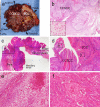Clear Cell Squamous Cell Carcinoma of the Maxillary Gingiva Associated with PIK3CA and HRAS Mutations: Report of a Case and Literature Review
- PMID: 37735286
- PMCID: PMC10739645
- DOI: 10.1007/s12105-023-01580-8
Clear Cell Squamous Cell Carcinoma of the Maxillary Gingiva Associated with PIK3CA and HRAS Mutations: Report of a Case and Literature Review
Abstract
Background: Squamous cell carcinoma (SCC) is the most common oral malignancy, and somatic mutations in some driver genes have been implicated in SCC development. Clear cell SCC (CCSCC) is a rare histological variant of SCC, and various clear cell neoplasms must be considered in the differential diagnosis of CCSCC in the oral cavity. Based on a limited number of CCSCC cases reported in the oral cavity, CCSCC is considered an aggressive variant of SCC with a poor prognosis; however, its genetic characteristics remain unknown.
Methods: A maxillary gingival tumor in an 89-year-old female was described and investigated using immunohistochemical staining, special staining, fluorescence in situ hybridization, and next-generation sequencing (NGS) with a custom panel of driver genes, including those associated with SCC and clear cell neoplasm development.
Results: Histopathological examination revealed a proliferation of atypical epithelial cells with abundant clear cytoplasm and enlarged and centrally placed round nuclei. The tumor was exophytic with deep, penetrating proliferation. The atypical clear cells were continuous with the conventional SCC cells. Immunohistochemical analysis showed that the clear cells were positive for CK AE1/AE3 and CK5/6 and nuclear-positive for p63. In contrast, the clear cells were negative for αSMA, S100, HMB45, Melan-A, CD10, and p16. p53 immunoreactivity exhibited a wild-type expression pattern. Additionally, the clear cells were positive for periodic acid-Schiff (PAS) and negative for diastase-PAS, mucicarmine, and Alcian blue. Based on these results, the diagnosis of CCSCC was confirmed. Molecular analysis of the clear cells identified PIK3CA p.E542K (c.1624G>A) and HRAS p.G12A (c.35 G>C) somatic mutations classified as oncogenic. No pathogenic variants were identified in TP53, EWSR1, AKT1, PTEN, BRAF, KRAS, NRAS, RASA1, or MAML2.
Conclusions: We report a case of CCSCC of the oral cavity with PIK3CA and HRAS mutations. The identification of PIK3CA and/or HRAS mutations is rare in SCC; however, both mutations are important potential targets for antitumor therapy. A detailed analysis of gene mutations in CCSCC may lead to a better understanding of its biological behavior and an improved prognosis, as well as a differential diagnosis from other clear cell neoplasms.
Keywords: Clear cell squamous cell carcinoma; HRAS; Oral tumor; PIK3CA; Squamous cell carcinoma.
© 2023. The Author(s).
Conflict of interest statement
All authors state that they have no conflicts of interest.
Figures





Similar articles
-
Squamous cell carcinoma initially occurring on the tongue dorsum: a case series report with molecular analysis.Diagn Pathol. 2024 Apr 22;19(1):63. doi: 10.1186/s13000-024-01487-0. Diagn Pathol. 2024. PMID: 38650013 Free PMC article.
-
Clear cell squamous cell carcinoma of the tongue exhibits characteristics as an undifferentiated squamous cell carcinoma.Pathol Res Pract. 2022 Jul;235:153909. doi: 10.1016/j.prp.2022.153909. Epub 2022 Apr 26. Pathol Res Pract. 2022. PMID: 35552085
-
Identification of molecular targets in vulvar cancers.Gynecol Oncol. 2017 Aug;146(2):305-313. doi: 10.1016/j.ygyno.2017.05.011. Epub 2017 May 20. Gynecol Oncol. 2017. PMID: 28536037
-
Understanding PI3K/Akt/mTOR signaling in squamous cell carcinoma: mutated PIK3CA as an example.Mol Biomed. 2024 Apr 15;5(1):13. doi: 10.1186/s43556-024-00176-0. Mol Biomed. 2024. PMID: 38616230 Free PMC article. Review.
-
Molecular events in the pathogenesis of vulvar squamous cell carcinoma.Semin Diagn Pathol. 2021 Jan;38(1):50-61. doi: 10.1053/j.semdp.2020.09.010. Epub 2020 Sep 25. Semin Diagn Pathol. 2021. PMID: 33032902 Free PMC article. Review.
Cited by
-
Clear Cell Variant of Oral Squamous Cell Carcinoma: A Rare Case.Cureus. 2025 Jan 14;17(1):e77450. doi: 10.7759/cureus.77450. eCollection 2025 Jan. Cureus. 2025. PMID: 39958039 Free PMC article.
-
Infrequent Histopathologic Subtypes of Oral Squamous Cell Carcinoma: A Case Series with Emphasis on Histopathologic Characteristics.J Dent (Shiraz). 2025 Jun 1;26(2):186-193. doi: 10.30476/dentjods.2025.103223.2435. eCollection 2025 Jun. J Dent (Shiraz). 2025. PMID: 40510230 Free PMC article.
-
Decoding the Rarity: A Unique Case of Clear-Cell Variant of Oral Squamous Cell Carcinoma.Cureus. 2024 Sep 1;16(9):e68389. doi: 10.7759/cureus.68389. eCollection 2024 Sep. Cureus. 2024. PMID: 39355464 Free PMC article.
-
Squamous cell carcinoma initially occurring on the tongue dorsum: a case series report with molecular analysis.Diagn Pathol. 2024 Apr 22;19(1):63. doi: 10.1186/s13000-024-01487-0. Diagn Pathol. 2024. PMID: 38650013 Free PMC article.
References
-
- El-Naggar AK, Chan JKC, Grandis JR, Takata T, Slootweg PJ, editors. World Health Organization classification of head and neck tumours. 4. Lyon: IARC; 2017. pp. 108–111.
-
- Elder DE, Massi D, Scolyer RA, Willemze R, editors. World Health Organization classification of skin tumours. 4. Lyon: IARC; 2018. pp. 43–44.
Publication types
MeSH terms
Substances
LinkOut - more resources
Full Text Sources
Research Materials
Miscellaneous

